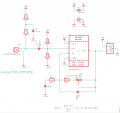Maybe some of you knowledgeable EE forum members can help me to reduce the ADC noise of my set-up?
Set-up:
What I tried:
Results:
Signal always shows strong downward spikes and is sort of wavy in layman's terms, also when microphone is exposed to 1 kHz sine wave from a tone generator; please see attached image below.
Is there anything that can be done, or is this low-end board just no good? Thanks!

Set-up:
- 5V DC wall-PSU MEANWELL GS12E05-P1I PSU powers a 5V Adafruit Metro Mini microcontroller
- Adafruit MAX4466 board powered by the microcontroller's 3.3V output pin
- Adafruit MAX4466 gain pot centered so at around 75 x gain (25 x to 125 x possible)
- All grounds connected
- Tested in very silent room with good sound proofing
What I tried:
- No fluorescent lamps or other electronic devices are present
- Collecting 512 samples with ADC default speed and double speed
- Standard 5V to the board, recommended 3.3V to the board with 3.3V analog reference voltage, recommended 3.3V to the board with 2.5V analog reference voltage
- No capacitors, or 0.1uF ceramic capacitors from ADC input to GND and analog reference voltage input pin to GND as recommended by Adafruit
- Used 3 Adafruit Metro Mini microcontrollers and 2 Adafruit MAX4466 boards, symptoms always identical
Results:
Signal always shows strong downward spikes and is sort of wavy in layman's terms, also when microphone is exposed to 1 kHz sine wave from a tone generator; please see attached image below.
Is there anything that can be done, or is this low-end board just no good? Thanks!










